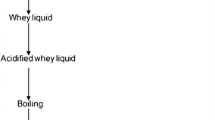Abstract
Natural fermentation of finger millet (Eleusine coracana) was carried out for 48 h. Microbiological and chemical analysis was performed throughout the fermentation process. The fermentation was heterolactic dominated by lactic acid bacteria accompanied by the production of lactic and acetic acids with decrease in pH and increase in titratable acidity. The microbial population increased until 18 to 24 h accompanied by a rapid decrease in total and reducing sugars. The microflora stabilized between 24 and 48 h, during which time the total and α-amylase activities increased with accumulation of sugars. Total free amino acids also increased. Yeast counts were low and moulds and coliforms were absent. Repeated fermentations showed consistency in the qualitative and quantitative changes in microflora. Five predominant types of bacteria, strains belonging to Leuconostoc, Pediococcus and Lactobacillus were identified. Of these only one type, Pediococcus, dominated (>80%) in the latter half of fermentation.
Similar content being viewed by others
References
Achi, O.K. 1990 Microbiology of obiolor: a Nigerian fermented non-alcoholic beverage. Journal of Applied Bacteriology 69, 321-325.
Aliya, S. & Geervani, P. 1981 An assessment of the protein quality and vitamin B content of commonly used fermented products of legumes and millets. Journal of the Science of Food and Agriculture 32, 837-842.
Anderson, R. & Hedlund, B. 1983 HPLC Analysis of organic acids in lactic acid fermented vegetables. Zeitschrift Lebensm unters Forsch 176, 440-443.
Bernfield, P. 1955 Amylases, alpha and beta. In Methods in Enzymology, eds Colowick, S.P. & Kaplan, N.O. pp. 149-158. London: Academic Press.
Brouk, B. 1975 Plants consumed by man, pp. 386-393. London: Academic Press.
Chavan, J.K. & Kadam, S.S. 1989 Nutritional improvement of cereals by fermentation. Critical Reviews in Food Science and Nutrition 28, 349-400.
Dhanker, N. & Chauhan, B.M. 1987 Technical note: Preparation acceptability and B-vitamin content of rabadi-fermented pearl millet food. International Journal of Food Science and Technology 22, 173-176.
Dubois, M.K. Gilles, K.A., Hamilton, J.K., Rebers, P.A. & Smith, F. 1956 Colorimetric method for determination of sugars and related substances. Analytical Chemistry 28, 350-356.
Egan, H., Kirk, R.S. & Sayer, R. 1981 Pearson's Chemical Analysis of Foods, 8th edn. London: Churchill Livingstone.
Holt, J.G., Krieg, N.R., Sneath, P.H.A., Staley, J.T. & Williams, S.T. 1994 Bergey's Manual of Determinative Bacteriology. 9th edn. pp. 529-543, 566. Baltimore: Williams & Wilkins.
Khetarpaul, N. & Chauhan, B.M. 1990 Effect of fermentation by pure cultures of yeasts and lactobacilli on the available carbohydrate of pearl millet. Food Chemistry 36, 287-293.
Khetarpaul, N. & Chauhan, B.M. 1991 Sequential fermentation of pearl millet by yeasts and lactobacilli: changes in available carbohydrate content. Food Chemistry 40, 235-240.
Khetarpaul, N. & Chauhan, B.M. 1992 Sequential fermentation of pearl millet by yeasts and lactobacilli: effect on anti-nutrients and in-vitro digestibility. Plant Foods for Human Nutrition 41, 320-324.
Magne, C. & Larher, F. 1992 Higher sugar content of extracts interferes with the colorimetric determination of amino acids and free proline. Analytical Biochemistry 200, 115-118.
Malleshi, N.G. & Hadimani, N.A. 1993 Nutritional and technological characteristics of small millets and preparation of value added products from them. In Advances in Small Millets, ed Riley, K.W., Gupta, S.C., Seetharam, A. & Mushong, J. N. pp. 270-287. New Delhi: Oxford and IBH Publishing Company.
Miller, G.L. 1959 Use of di-nitrosalicylic acid reagent for determination of reducing sugar. Analytical Chemistry 31, 426-428.
Nanson, N.J. & Flelds, M.L. 1984 Influence of temperature of fermentation on the nutritive value of lactic acid fermented corn meal. Journal of Food Science 49, 958-959.
Nout, H.J.R. & Rombouts, F.M. 1992 Fermentative preservation of plant foods. Journal of Applied Bacteriology Symposium Supplement 73, 136S-147S.
Rajyalakshmi, P. & Geervani, P. 1990 Studies on tribal foods of South India: Effect of processing methods on the vitamin and in-vitro protein digestibility of cereals, millets and legumes. Journal of Food Science and Technology, 27, 260-263.
Riley, K.W., Gupta, S.C., Seetharam, A. & Mushonga, J.N. 1993 Advances in Small Millets. New Delhi: Oxford and IBH Publishing Company
Seetharam, A. 1994 Agriculture Situation in India. Directorate of Economics and Statistics, Department of Agriculture and Cooperation, Ministry of Agriculture. August, 343-348.
Semeniuk, G. 1954 Microflora. In Storage of Cereal Grains and Their Production, ed Anderson, J.A. & Aclock, A.W. pp. 77. St. Pauls MN: American Association of Cereal Chemists.
Soni, S.K. & Sandhu, D.K. 1989 Nutritional of Indian dosa batters by yeast enrichment and blackgram replacement. Journal of Fermentation and Bioengineering 68, 52-55.
Taur, A.T, Pawar, V.D. & Ingle, U.M. 1984 Effect of fermentation on nutritional improvement of grain sorghum (Sorghum biocolor (L) Moench). Indian Journal of Nutrition and Dietetics 21, 129-136.
Umeta, M. & Faulks, R. 1988 The effect of fermentation on the carbohydrates in tef (Eragrostis tef). Food Chemistry 27, 181-189.
Umeta, M. & Faulks, R. 1989 Lactic acid and volatile (C2-C6) fatty acids production in the fermentation and baking of tef (Eragrostis tef). Journal of Cereal Science 9, 91-95.
Usha Antony, Sripriya, G. & Chandra, T.S. 1996 Effect of fermentation on the primary nutrients in finger millet (Eleusine coracana). Journal of Agricultural and Food Chemistry. (in press).
Vaidehi, M.P. Bharati, P & Reddy L. 1985 High protein biscuits made with ragi flour and oilseed flour blends. Food and Nutrition Bulletin 7, 61-64.
Venkatasubbiah, P., Dwarakanath, C.T. & Murthy, V.S. 1985 Involvement of yeast flora in idli batter fermentation Journal of Food Science and Technology 22, 88-90.
Author information
Authors and Affiliations
Rights and permissions
About this article
Cite this article
Antony, U., Chandra, T. Microbial population and biochemical changes in fermenting finger millet (Eleusine coracana). World Journal of Microbiology and Biotechnology 13, 533–537 (1997). https://doi.org/10.1023/A:1018561224777
Issue Date:
DOI: https://doi.org/10.1023/A:1018561224777




